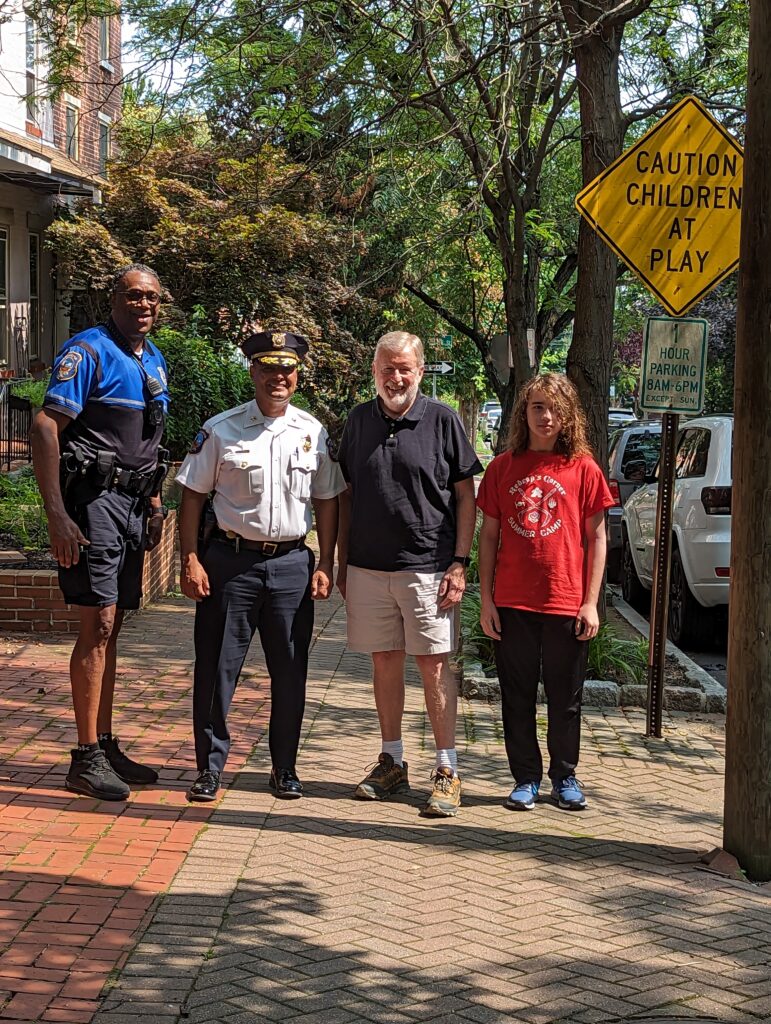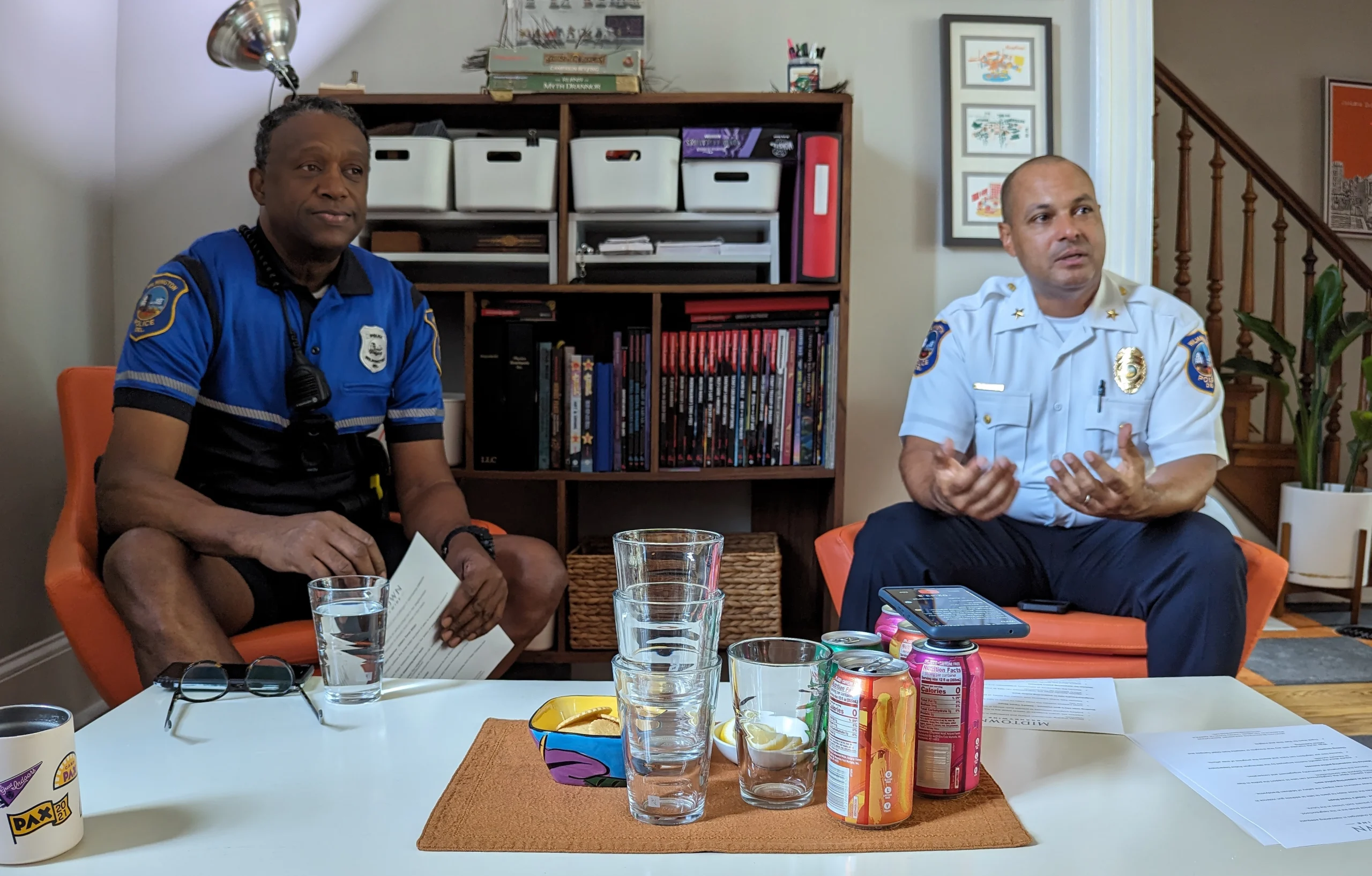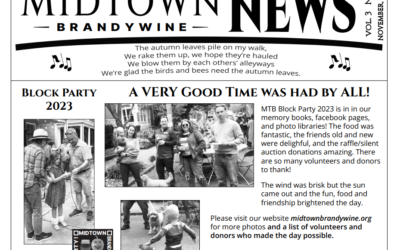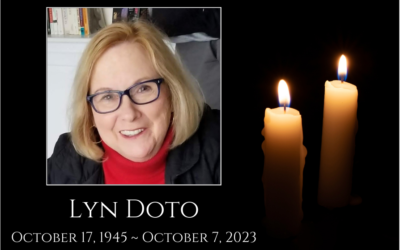An interview with Wilmington Chief of Police Wilfredo Campos.
In a wide-ranging discussion in early August 2023, Wilmington’s new Chief of Police, Wilfredo Campos and Master Corporal Anthony Easterling (who is responsible for the area of Wilmington that includes Midtown Brandywine) sat down with Midtown Brandywine News to talk about the Chief’s vision for community policing and engagement and current conditions across Delaware’s largest city.
Chief Campos, selected as the 33rd Chief of Police, joined the Wilmington Police Department 26 years ago and has pursued a remarkable career of service to his communities. He is the department’s first Hispanic chief.
Master Corporal Anthony Easterling graduated from the same police academy year as Chief Campos, and the two officers have closely collaborated for the public good over more than two decades.
This interview was conducted by Bob Blanchard, chair of the Midtown Brandywine Neighbors’ Association public safety committee, and Simon Cousins, chair of the Association’s communications committee and editor of Midtown Brandywine News.
Chief Campos’ journey from a Wilmington West Side childhood to the city’s chief of police
Chief of Police Wilfredo Campos: “I was born in Puerto Rico, and we moved here to Wilmington when I was eight. My mother, my brother, my sister, and we settled on the city’s west side, on 6th and Broom. I went to William C. Lewis Elementary School – that was when kids were able to walk to school and you knew the whole neighborhood would watch you. From there I went to H.B. Dupont Middle School, then Stanton Middle School and I finally graduated from Thomas McKean High School. After high school I joined the Army Reserve and trained in Oklahoma for boot camp and Missouri for my other training. Then I came back to Wilmington knowing I’d go into some type of law enforcement. I knew police officers growing up, and I’d always respected and looked up to the police. So, I was pretty clear about my preferred career path once I’d joined the military and learned the value of discipline and structure.
“So, when I returned home, the police department wasn’t hiring yet, so due to my military training for heavy equipment operation and transportation, I worked for DART for two years. Eventually the Wilmington Police Department opened a hiring opportunity. I applied, was hired, and joined the 84th Police Academy in 1996 with this man here, Anthony Easterling.”
Master Corporal Anthony Easterling: “Not only did we graduate the 84th academy together, but we sat next to each other!”
Chief Campos: [Laughs] “Anthony was our class president and as you probably know, Anthony was a U.S. Marine and served overseas in the ‘80s. After graduation I worked my way up through the ranks, starting in uniformed services, like everyone does, doing patrol work. From there I went to community policing and was a bike officer on the west side, then I went to detectives for about nine years, investigating everything from burglaries, robberies and thefts, and then eventually homicides. When there was an opening in the ATF task force, I applied for that and worked in ATF for a little more than a year. I got to learn the federal side of law enforcement and crime, especially around trafficking and possession of firearms.
“From ATF I moved over to the human resources division, and I had an opportunity to be one of the instructors in the police academy. I got promoted there and ran police academies, hiring processes, recruitment, and training for about five or six years. I was promoted and went to back to uniformed services, then back to the police academy as a sergeant, then was promoted again from the police academy to lieutenant in uniformed services and then about a year later, in 2017, I was promoted to captain under Chief [Robert] Tracy, in charge of sector three for five and a half years.”
Everything matters
Chief Campos: “We have three sectors in the city: everything west of the I-95 is sector three, and Midtown Brandywine is in sector two. So, my command was everything west of the I-95, from the Brandywine River south to Maryland Avenue and all the way out to Dupont Road. That’s a pretty big area and encompasses a lot of different, very diverse neighborhoods, and each neighborhood has its own issues. I had to wear many hats and juggle different issues for each neighborhood, from parking issues to violent crime. It was this experience that led me to understand that ‘everything is important.’
“You see, if there are ongoing issues with, say, parking, and if you don’t address those issues, that can lead to bigger problems, including the possibility that an issue could turn violent. So, I always say, everything matters. From someone breaking into a vehicle to shoplifting to parking issues to speeding issues, to shootings, to homicides, everything matters. It’s important that the police department helps people by addressing all those issues, so we can keep the peace and we can all live our lives comfortably.
“In early 2023, when Chief Tracy decided to move on to a bigger department, I interviewed for the chief of police job and Mayor Purzycki offered me the opportunity. I accepted it [laughs] and here I am, 27 years with Wilmington police in September this year.”
Wilmington’s community policing, or as the Chief prefers, ‘community engagement’

From left: Anthony Easterling, Chief Wilfredo Campos, Bob Blanchard, Kepler Davis-Cousins are pictured in Midtown Brandywine, Wilmington DE in August 2023
Chief Campos: “One of the strategies I learned as a sector captain in Wilmington is to keep the same officers working the same neighborhoods, so that those officers get to know the local people and conditions. If you’re constantly moving your officers from one side of the city to the other, it’s more difficult for officers to understand and resolve issues. And that misses an opportunity to create a good relationship with the community because they see a different officer every time. Keeping the same officers in the same areas and districts and going to community meetings to hear the concerns of the residents firsthand is key to Wilmington’s approach to community policing. I choose to call our approach community engagement because it’s a lot more than just policing. You’re engaging and collaborating with the community for the common good.
“Community engagement has the potential to resolve situations so simply. Let’s say there’s an abandoned vehicle and neighbors have been calling for two or three months and nothing’s happening with that vehicle. Well, when the neighborhood’s officers and their captain come to neighborhood meetings, the issue is likely to be addressed right after the meeting. Community engagement is how you build trust and relationships, and residents know that we’re listening to them.
“Wilmington has some neighborhoods where some people will just dump their old mattress or couch or washing machine on the pavement. That creates blight and a social environment where other people think that it’s okay to commit crime because ‘this neighborhood doesn’t care.’ But when you apply community engagement our officers can assist neighbors to liaise with public works, for example, that can help clear that kind of blight and that helps to make a better, safer neighborhood.
“Community engagement really helps avoid big problems spawning from relatively small problems. Imagine a vacant property that attracts squatters that leads to cars being broken into and a housefire that can spread to neighboring properties.
“Our approach to community policing, community engagement strategy is good, and I hope the Midtown Brandywine community feels that too.”
Anthony Easterling: “Without a doubt, Chief Campos is right. Community policing and community engagement is personally my favorite role over my entire career. We have a mission statement at the police department: To work in a true partnership with our fellow citizens to raise the level of public safety through law enforcement, thereby reducing the fears and incidences of crime. And it says, this mission will be fostered by every member of the department.
“That mission statement was created by Chief Samuel Pratcher, who is retired, and we have chief Campos taking it forward now. We’ve always adhered to that mission statement, and it inevitably instills itself within the officers who perform those duties. Community policing is not new; it has always existed. However, it’s personified by officers and neighborhoods who take a direct approach to quell incidences of crime.
“Here in Wilmington, it generally works, but sometimes it doesn’t. I’ve found the reason it sometimes doesn’t work is because of distrust of the police. But when you help residents become aware of what’s going on in their community, they become more enlightened.”
Chief Campos: “So, you have that communication, and I think the community sees that we’re out there with them and we’re formulating plans with neighborhoods and communities. Partnership with communities means residents don’t leave their three-thousand-dollar bike on their car’s bike rack because that just gives an opportunity for someone to say, I’m gonna try to take this bike. So much trouble is preventable. I think we’ve all come a long way to reduce a lot of these preventable crimes.”
Community engagement in Midtown Brandywine
Anthony Easterling: “The number one thing that I love about Midtown Brandywine is the community chili cook-off! Everybody participates, everybody has a say. But we’ve been through some storms together, even before the pandemic. Over the years, we’ve worked in the true partnership with our fellow citizens, and we have leveraged that partnership to raise the level of public safety and law enforcement. Together, we’re reducing the fears and incidences of crime.”
Chief Campos: “The main thing that we’re seeing now is there’s a TikTok video out there that shows kids how to steal Kias and Hyundais with USB cord. So, a lot of Kias are being broken into because some kids are trying to learn how to do it, but they’re breaking the window and the ignition, and then that’s as far as it gets. But there are also kids who have learned the technique.
“As a response to the Kia and Hyundai risk we have a program that they will give you ‘The Club,’ a physical security device, free of charge. If you live Wilmington and you show up with a Kia or Hyundai we’ll give you a free Club. So far we’ve I think we’ve given away more than 300.”
Anthony Easterling: “When I first started working here in Midtown Brandywine, the problem was that everybody left everything in their cars, so we had way too many vehicle break-ins. Some residents of the time were saying the police weren’t doing their jobs. So, I printed up a card which I’d put on the broken-into cars, saying the reason your car was broken into is because you have everything sitting on the seat.
“A couple of those residents would tell me that they had the right to leave whatever they wanted on their car seats. But no, I’d say, no, you don’t. And the reason, I’d say, is because doing that attracts criminals.
“These days, Midtown Brandywiners know that by not leaving stuff on your seat, for example, you’re contributing to a better, safer, more peaceful neighborhood. Lately, I’m providing training in ‘CPTED‘, Crime Prevention Through Environmental Design, which is a part of community policing to reduce the fear and incidences of crime. It’s a very simple process, but the totality of it is to get the neighborhood involved.”
Midtown Brandywine News: What would you like to see from a small neighborhood like Midtown Brandywine? How can we help support your efforts?
Chief Campos: “I think Anthony really nailed it earlier: communication. There are a lot of things that the police department responds to that are preventable, with more communication.”
On resourcing levels for policing in Wilmington
Chief Campos: “Here in Wilmington our authorized strength is 312 officers and right now we’re at 290, which means we are down, but it’s only about 7%. We’re consistently aiming for full strength of course, but our resources are mostly fine here. I was able to move some people around to create the communication unit without affecting overall department effectiveness.
“So, I’m happy to say we’re doing fine. I just got back from Baltimore, meeting with FBI Director Wray and Baltimore region chiefs and commissioners, and it was clear to me that Wilmington hasn’t been so adversely affected by the police recruitment problems as in other parts of the US. The Baltimore commissioner told me their department should be 3,000 but they’re down to around 1,900 officers, down a third.
“The officers the WPD’s lost recently have either been to retirement (we just had a guy retire after 34 years with the police department), or to the Delaware State Police, or to a relevant career opportunity. We’re not losing officers due to frustration.
“As the new chief, I’m focusing on allocation and reallocation of our resources to have my vision of the department come to fruition.
“In our new Community Engagement Unit, we have nine people with a sergeant and a lieutenant, and I do wish it could be bigger, but we do have the 102nd Wilmington Police Academy starting August 7th.
“Just this week we began recruitment of certified police officers from Delaware, the surrounding region, and across the country who are looking to move to our department without having to go through our entire police academy. It was always ‘I would love to come to Wilmington, but I don’t want to do another academy’, so this is a great opportunity for qualified, experienced officers who might have been working in smaller community departments and are looking for new challenges. We’ll be presenting these good recruits to the council and Delaware State Police for review, so we can be crystal clear what this person needs to be certified as a police officer in Delaware. For those individuals, we’ll provide training to learn our policies and procedures and after passing the Delaware COPT examination, they can be onboarded without full academy requirements.
“For a lot of these recruits, this is a great opportunity to move to a bigger department with a bigger salary, and they can move around to detectives or the marine unit or motorcycles for example, and it helps Wilmington to fill our vacancies with experienced people and get us back up to full strength.
“When Anthony and I came onto the force in 1996, I think we were authorized to be at 279 officers, and we had 219. So, we’re doing pretty well historically, and very well when compared to many other police departments.”
Anthony Easterling: “Chief Campos has hit the nail on the head because we’re all competing for recruits. And with the new recruitment program, we make sure that they adhere to Wilmington expectations and understand that ‘this is how we do it, this is how it works.’ The chief implements that process very, very well.”
What does an average work week for the Chief look like?
Chief Campos: “Every Monday, I have a 10:30AM staff meeting with every captain who’s working at the time. We go through our shot spotter data, and things that happened over the weekend, what’s coming up for that week, and personnel. This is to make sure we didn’t miss something, what’s the follow-up, what could have been prevented. We review how the investigations are going, the videos and witnesses, what is the physical evidence, and is there a tie-in to other issues we’re having?
“And then on Wednesday, we meet again to talk about what happened from Monday to Wednesday, as well as personnel issues that may arise.
“Then Thursday is our big day, where we have our CompStat meeting from 9:00 to 11:00AM. That’s where I hold my captains accountable for what happens in their sector, everything from shoplifting to homicide. Everyone’s in there: our command staff, our real-time crime center intelligence people, our CGIC [Crime Gun Intelligence Center] group. We have our support staff there as well, so that everyone knows what’s going on, not just the captains, the lieutenants, and the sergeants… we bring patrol officers to sit in and hear what’s going on throughout the city and how we plan for it and how we respond to it. This is where we hold ourselves accountable. It’s basically a business model approach to policing.
“I mentioned we apply CompStat, which was started in New York City in the ‘90s. CompStat measures your department over a seven-day period, from Sunday to Sunday. We measure our week to the same week last year because you can’t compare January to a week in July, right? The conditions are different. Then we compare the current 28-day period to the same 28-day period from last year, and then, finally, this year-to-date versus last year-to-date. So, with these rolling comparisons, we can see how we’re doing with crime.
“It’s the 28-day period when you start seeing trends. You’re like, oh, wait a minute, how come these robberies are up, and where are these robberies happening, and what is the tie-in? Is it the same group of individuals or is it separate individuals? So, we talk about that to make sure that if it’s if it is one group, let’s identify who this group is, and let’s formulate a plan to respond to it.
“So, you see there’s a lot of communication going on throughout the Wilmington police department. We always say, ‘crime is going to happen, so it’s a matter of how we respond to it.’ It’s how we respond to it that can prevent the next robbery and even eliminate the problem from that neighborhood, and excellent communication is key.
“Then on Friday, we meet again at two o’clock to talk about what’s coming up for the weekend. Whether it’s the neighborhood Chili Cook-Off event in Midtown Brandywine or an event at the Riverfront, or President Biden coming to the Chase Center. You name it, we want to be sure that we’re prepared, so that if something were to happen, we’re not caught off guard and we’re ready to respond appropriately.”
On the next five years
Chief Campos: “When we review our metrics year-to-date, we project previous years, going back as far as seven years. This is so we understand how we’ve been reducing crime in particular categories as well as overall crime.
“As of right now [August 2023], we’ve been able to reduce shootings from 2021 to 2023 by about 25 percent and homicides by 63 percent. These are among the lowest numbers we have seen in the past 15 years.
“My goal and my challenge to my staff is to continually improve on that. So far this year, we’re one percent year-to-date in part one crimes, shootings are down four percent and homicides are down I believe something like 10 percent. We’re moving in the right direction, but we always say, ‘one shooting is too much.’
“For our captains, it’s a personal challenge and they really take ownership of it.
“Looking forward, one of my key initiatives was to secure a grant from the Bureau of Justice Assistance in Baltimore, working through the ATF for a $700,000 program over three years. They recently came in and assessed our whole response on shootings, failed shootings, which is when somebody shoots a gun at somebody and misses, and shooting homicides. They studied how we secure a crime scene, collect the casings, how we identify whether this gun was used in other areas and what other crimes the gun has been linked to. They sat in on our GunStat meetings and our intelligence staff, and individuals who’ve been arrested for illegal possession of firearms. They sat in on our meetings with the mayor, the state attorney general and prosecutors, the governor’s office and divisions of family services and rehabilitative services, the federal prosecutors, and the way we track and analyze all our metrics. These are our monthly meetings, getting all these people into the same room, and I honestly don’t think many other chiefs in the country can get this caliber of people around the table every month. This level of support doesn’t happen everywhere.
“The ATF evaluation came in and it said the WPD is way ahead of the game. Their report only had four recommendations. One was to create a gun intelligence unit, which basically follows up on firearms that have been recovered from gun trafficking and straw purchases. Another, and it’s being built right now, is a gun lab with a forensic firearms examiner who can trace that gun’s history in real time. This will help the wider community because other departments can bring in firearms so we can help them move their investigations along at a quicker pace. At present, most handguns are taken to the Delaware State Police in Dover so soon we’ll have our own forensic examiner as part of this grant as well as crime analysts to help further reduce gun violence.
“Another area I’m focusing on is mental health, which has been a community problem that went through the roof during the Covid pandemic and quarantine. We have a substantial population of residents who are struggling with mental health issues, often compounded with drug or alcohol addictions, as well as people coming back from the military with mental health issues. To address this expanding problem in the community I’m in the process of creating a co-responder initiative, working with ChristianaCare and all my state partners.
“I had a meeting the other day with the lieutenant governor and the Delaware state mental health unit to advance this new program that will pair-up ChristianaCare mental health clinicians with my police officers to better respond to mental health calls for assistance. A lot of these calls are for somebody to talk to, or because they haven’t gotten their medicine, and that might seem minor, but it has the potential to escalate, and that can shut a whole neighborhood down while we negotiate with someone who’s now threatening to hurt themselves or others. With our new program, we can get ahead of that to respond (and even be proactive) to help these folks get the care they need.
“And I must say this: these things wouldn’t be possible for me to do if I didn’t have Mayor Purzycki’s support. I know I’m supported one hundred percent. And I want to say that because that just doesn’t happen in a lot of cities.”
Midtown Brandywine News is grateful to Chief Campos and Master Corporal Easterling for generously providing us with the time necessary for such a wide-ranging conversation, and to Senior Corporal Lisa Flores for her invaluable assistance.
This story originally appeared in Midtown Brandywine News, September 2023. Photos by Kepler Davis-Cousins.




















